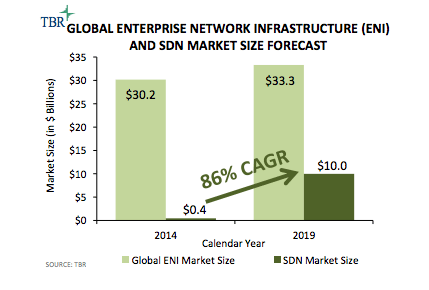TBR report cites increased customer adoption of SDN indicates technology ‘here to stay’
The enterprise market and continued adoption of open standards is driving the maturation of the software-defined networking market, according to a recent report from Technology Business Research.
In its findings, TBR noted maturing of the enterprise SDN market is being bolstered by increased customer adoption, which it said indicates the market is “here to stay.” The developing market includes early adopters completing trials, “which will transition into mainstream adoption by 2020.”
“SDN will become a substantial contributor to the overall network infrastructure market,” explained Krista Macomber, a TBR data center analyst. “Production deployments started within a number of large-scale enterprise environments, and will spread across the industry as standards bodies gain momentum and vendors expand solutions and use cases.”
The market’s willingness to adopt open standards is also helping to push further adoption of SDN, according to TBR, including broader use cases in the areas of security and mission-critical application availability. This is expected to continue as enterprises look to further enhance financial benefits of SDN as the technology matures.
“Customers recognize the potential of software-defined architectures in solving pressing pain points such as management complexity and workload inflexibility,” said Christian Perry, a TBR principal analyst and practice manager. “However, barriers to adoption including internal resistance to change and industry immaturity remain. For vendors, proving the performance and reliability of solutions is a critical first step to adoption.”
As for vendors in the space, TBR said the move toward hardware commoditization is allowing software vendors and commodity hardware vendors to gain market share. The research firm cited potential gains for the likes of VMware and Dell at the expense of Cisco Systems, although incumbents are likely to highlight their end-to-end value proposition.
“As software-centric vendors provide an avenue for customers to avoid pricey and complex hardware installations, industry incumbents message the value to customers of optimization not only for overlay capabilities, but also for physical workloads and connections to optimize performance and scalability,” TBR noted. “In turn, these efforts will help to protect vendors’ footholds in the market.”
AT&T, which has been one of the more vocal proponents of virtualization technology using SDN and network functions virtualization, recently cited a proof-of-concept technology called software-defined storage that it claims “creates a software layer on top of commercial disks to address enterprise cloud storage needs.”
In a blog post, Chris Rice, VP at AT&T Labs, said the PoC resulted in a “fully automated way to build customer storage plans,” that he added can be accomplished in minutes instead of the weeks it normally takes to engineer and deploy traditional storage solutions. The platform also allows enterprises to use a Web interface to “tweak the dials” on different parameters, including cost control, reliability and performance.
Infonetics Research in a report earlier this year found 79% of the 153 medium-sized and large businesses surveyed plan to deploy live SDN solutions in data centers by the end of 2017. Those deployment plans look set to favor the more-established players in the market, although Infonetics said it was surprised by the number of enterprise customers also looking at alternatives.
“As SDN in the enterprise data center grows legs in 2015, thought leadership in this nascent market will give way to market share leaders with measurable revenue,” said Cliff Grossner, research director for data center, cloud and SDN at Infonetics Research. “Now is the time for existing and new vendors to grab market share. Respondents are moving from lab trials in 2015 to production trials in 2016 and to live production in 2017.”
Bored? Why not follow me on Twitter


